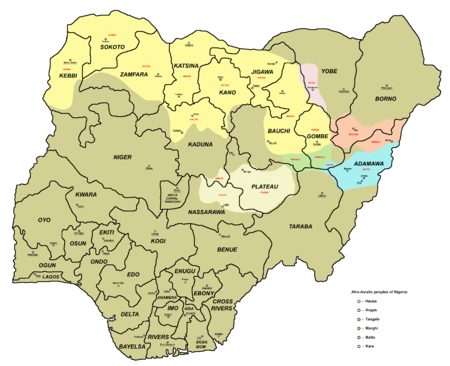Margi language
| Margi | |
|---|---|
| Native to | Nigeria |
| Region | Borno State, Adamawa State, Yobe, Gombe State |
Native speakers | 160,000 (2006)[1] |
|
Afro-Asiatic
| |
| Language codes | |
| ISO 639-3 |
mrt |
| Glottolog |
marg1265[2] |
 Ethnic territories of the Marghi-speaking people in Nigeria (pinkish red) | |
Margi, also known as Marghi and Marghi Central, is a Chadic language spoken in Nigeria, Cameroon, and Chad. It is perhaps the best described of the Biu–Mandara branch of that family. Marghi South and Putai are closely related and sometimes considered dialects of Margi.[1]
Phonology
Vowels
Margi is noted for having a vertical vowel system, with only two vowels, /ɨ/ and /a/, in native vocabulary. (Loan words also distinguish /ɛ/ and /o/.)
Consonants
Margi has a large consonant inventory, with a number of labialised consonants and unusual phones such as a labiodental flap. Hoffmann (1963) describes 84 consonantal phonemes, an enormous number compared to that of most languages, equivalent to that of Ubykh as the largest inventory of any language without clicks. However, Hoffmann's list of consonants includes all onsets in the language. Many of them have since, by other researchers, been analysed as sequences, such as /pt/ and /bz/.[3] There are 66 consonants that remain if labialisation is counted separately, 54 if it is interpreted as a /Cw/ sequence.
| Labial | Dental | Alveolar | Lateral | Post- alveolar | Palatal | Velar | Labio- velar | Glottal | |
|---|---|---|---|---|---|---|---|---|---|
| Nasal | m mʷ | n | ɲ | ŋ | ŋʷ | ||||
| Glottalized | ɓ̰ ɓ̰ʷ | ɗ̰ | j̰ | w̰ | |||||
| Prenasalized | mp | nt ntʷ | nts ntsʷ | ntʃ | ɲc | ŋk | ŋkʷ | ||
| mb mbʷ | nd | ndz | ndʒ | ɲɟ | ŋɡ | ŋɡʷ | |||
| Oral occlusive |
p pʷ | t tʷ | ts | tʃ | c | k | kʷ | ʔ | |
| b bʷ | d | dz | dʒ | ɟ | ɡ | ɡʷ | |||
| Fricative | f fʷ | s sʷ | ɬ ɬʷ | ʃ | [ç] | x | ʍ | ||
| v vʷ | z | ɮ | ʒ | [ʝ] | ɣ | ||||
| Approximant | l | j | w | ||||||
| Vibrant | ⱱ | r |
[ç] and [ʝ] are palatalised allophones of /x/ and /ɣ/, the latter of which is closer to an approximant [ɰ].[4] The closely related language Bura is similar but has a palatalised lateral series as well. /ⱱ/ is used in mimesis rather than in lexical vocabulary. The glottalised consonants /ɓ̰ ɓ̰ʷ ɗ̰/ have been described as either creaky voiced or implosive; according to Maddieson, they are evidently both, as in Hausa.[5]
The sequences that Hoffmann included in his consonant inventory are all labial–coronal:
- ps [fs], pɬ, pç [fç], pt, pts, ptʃ, mpt, mpts, mptʃ, bz [vz], bɮ, (bʝ [vʝ]), bd, bdz, bdʒ, mbd, mbdz, mbdʒ, ɓ̰ɗ̰, mn[6]
Tone
There are two tones, high and low, with some syllables unmarked for tone.
References
- 1 2 Margi at Ethnologue (18th ed., 2015)
- ↑ Hammarström, Harald; Forkel, Robert; Haspelmath, Martin, eds. (2017). "Marghi Central". Glottolog 3.0. Jena, Germany: Max Planck Institute for the Science of Human History.
- ↑ Ladefoged, Peter; Maddieson, Ian (1996). The Sounds of the World's Languages. Oxford: Blackwell. p. 344. ISBN 0-631-19814-8. There are very few true labial–coronal consonants in the world.
- ↑ Ladefoged, Peter; Maddieson, Ian (1996). The Sounds of the World's Languages. Oxford: Blackwell. p. 165. ISBN 0-631-19814-8.
- ↑ Ladefoged, Peter; Maddieson, Ian (1996). The Sounds of the World's Languages. Oxford: Blackwell. p. 85. ISBN 0-631-19814-8.
- ↑ There may be a few others, such as pɬ~mɬ, mʃ~mtʃ.
Further reading
- Hoffmann, C. 1963. A Grammar of the Margi Language. Oxford University Press for International African Institute, London.
- Maddieson, I. 1987. "The Margi vowel system and labiocoronals." Studies in African Linguistics, vol. 18, No. 3, Dec. 1987.